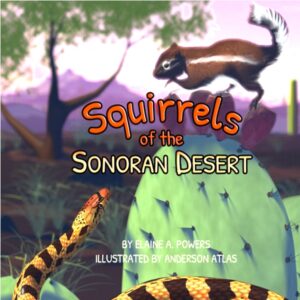Sometimes, stories are written to craft clarity from confusion. That’s certainly the case with my book Squirrels of the Sonoran Desert. I’ve lived in many places yet found myself perplexed by the local squirrels. In discussing them with other residents, it became clear that they were just as confused by the nature of these rodents. I was encouraged to write about them, and I’m very glad I did.
The Regular Squirrels
Growing up in Illinois, I was used to “normal looking” squirrels, those with the bushy tails. They would scamper up and down trees, run across power and telephone lines, and gather acorns. Sometimes they would position themselves upside down on a tree trunk and chitter at people or other animals passing by. These were the Eastern Gray Squirrel (Sciurus carolinensis). In both Illinois and New Jersey, the Eastern Chipmunk (Tamias striatus) is the resident species.
Squirrels are often viewed as pests: raiding bird feeders, utilizing human structures for their needs, or falling victim to electrical lines and causing power outages. However, while we may view many of their activities as amusing, they also demonstrate how clever squirrels really are. For instance, time and again they thwart humans’ best efforts to keep them out of bird feeders. This is natural for them; they didn’t evolve from the need to out-think people.
Squirrels are problem solvers, and notoriously plan in advance by storing food for the winter. At my home in New Jersey, the squirrels stored their walnuts on my second story porch at the top of the stairs. Not only was it easily accessible yet safe from competitors; my constant lurking provided a bonus measure of protection for their stash.
The Sonoran Squirrels
When I saw chipmunk-like rodents in my Tucson, Arizona yard, I was delighted. Chipmunk holes never bother me. In fact, I find the little critters’ white stripes along their brown fur quite attractive. So, why am I describing squirrels and chipmunks in other states, even though I live in Tucson? Because when I moved here, a black, fluffy-tailed squirrel lived in my mesquite tree and little chipmunks scampered about the landscaping rocks. Or were they something different?
In fact, the three squirrel species in the Sonoran Desert are all ground squirrels, no matter their appearance. The fluffy-tailed squirrel in my mesquite tree was a Rock Squirrel. Those cute chipmunks scurrying about are Harris’s Antelope Squirrels. And finally, the miniature prairie dogs who dig through the hard ground and road asphalt are Round-tailed Squirrels.
What are the differences between tree and ground squirrels? Ground squirrels use their tunnels for life activities: sleeping, food storage, family dens and protection from predators. In contrast, tree squirrels live in trees and either utilize tree cavities or create nests from leaves, sticks and bark. Even though ground squirrels may climb into trees for food, it’s not where they make their homes.
All of this, and more, I learned in researching my book. A few highlights:
- Fluffy rock squirrel tails are for more than balance – they provide protection!
- In a battle between a rattlesnake and a ground squirrel, who would win?
- How do the three species co-exist in the same habitat?
- What purpose do the holes in your yard serve?
Find out all this and more in Squirrels of the Sonoran Desert!


